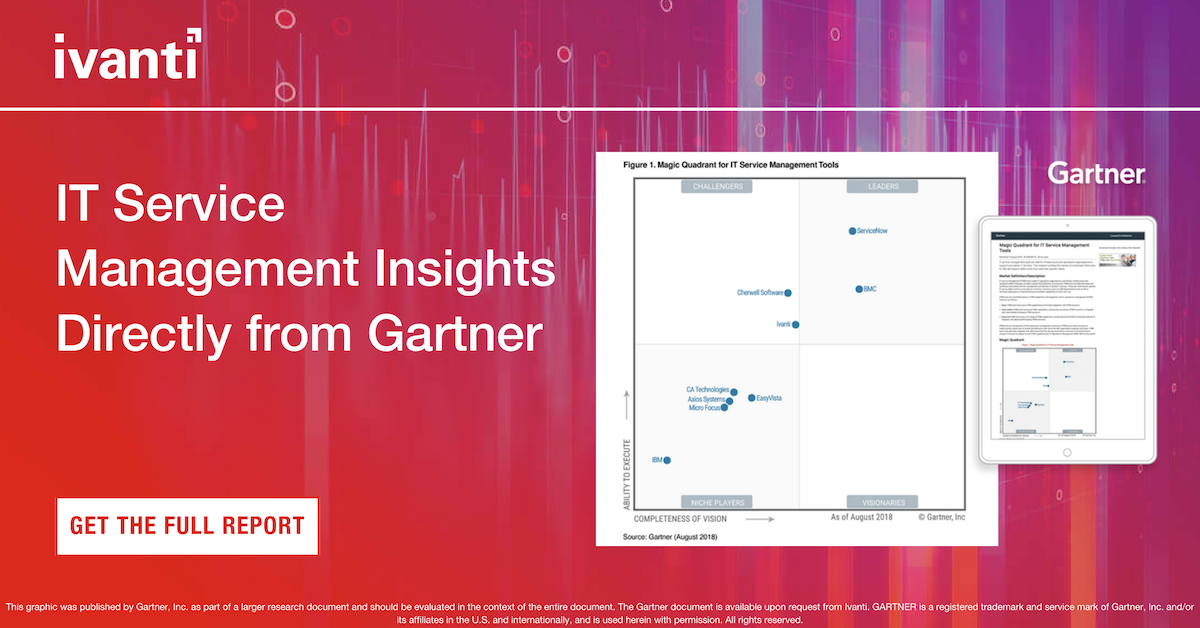The Criteria Behind the Curtain: 2018 Gartner MQ for ITSM Tools and 2018 Gartner Critical Capabilities for ITSM Tools
The 2018 Gartner Magic Quadrant and Critical Capabilities for ITSM reports were published recently. If you want to know how Ivanti fared, download the free reports below:
Many of you review, analyze, and use the reports as a shortlist tool to select a set of vendors and ITSM products for further evaluation. When you read the ITSM MQ report, you need to look beyond the Quadrant graphic. Your criteria are largely unique to your environment, your operation and your users. Examine the detail to get the full picture. This blog offers a behind-the-scenes glimpse into the submission process that the vendors undertook.
Firstly, the timing. The submission process kicked-off in February 2018. Vendors receive word from Gartner if they are selected for initial review. The communication included this year’s vendor and tool inclusion criteria. This changes year to year. For example, AI/Ops were introduced into the Critical Capabilities criteria for 2018.
The 2018 Gartner MQ for ITSM Tools criteria require that the software under assessment must include a set of functionalities defined by Gartner such as Incident management, SLA management, analytics, and reporting. There are inclusion and exclusion criteria for qualification to get recognized in the Gartner MQ for ITSM Tools. You can read these in detail in the report.
For inclusion in the 2018 Critical Capabilities for ITSM Tools, Gartner focuses on products that offer IT service support functions that focus on product usability and the ease of use of out-of-the box best practices. Gartner also focus on next-generation support capabilities specific to mobility and the use of big data, machine learning and social collaboration capabilities to increase effectiveness and efficiency levels. To be included in the 2018 Critical Capabilities research, all products evaluated must:
- Be available to be bought separately and be actively marketed by their vendors
- Include functionality for IT incident management, problem management, change management, IT user self-service (for knowledge and request management), IT KM, IT service support analytics and reporting, and SLA service-level management with regard to incident and service requests
- Have been generally available and been deployed in customer environments as of 1 March 2018
- Have appeared on at least 3% of Gartner client ITSM tool shortlists3 during 2017 or have provided a personalized demo and pricing for at least 120 prospects, with either an annual subscription contract value for ITSM software of at least $150,000, or a perpetual license contract value for ITSM software of at least $315,000 during 2017
Or:
- Have been the primary large-enterprise-focused ITSM product offered by a vendor appearing on the 2018 ITSM Magic Quadrant
Alongside the criteria, each vendor receives a market analysis survey, a tools analysis survey, and an ITSM Critical Capabilities demo script guideline. All ITSM tool providers review the information and confirm that their product meets the inclusion criteria.
From here on in, the fun begins. Vendors submit a set number of customer references that meet a list of criteria. This includes customer worldwide location, size of end users base that IT supports and software version employed. Finally, the customer must be using the ITSM tool to support and automate at least five processes from a list of seven presented. Customers had 15 days to respond to a Gartner survey. At no stage are the customer responses disclosed to the vendors.
Meanwhile, all vendors were feverishly responding to the ITSM MQ Market Analysis Survey. This assesses the ability to execute and completeness of vision. The survey requested information such as; customer programs, patents and percentage of customers that have upgraded, among many other data points. In parallel, the Product Analysis survey for the Critical Capabilities report is filled out. This survey requests information such as pre-built integrations aligned to the Gartner mini-suites. The survey requests pricing for a scenario of a set number of IT users and business users among other information.
Demonstrations are recorded covering over 50 points such as “Demonstrate the ability to configure process workflows with minimal scripting.” The duration of the recording must not step over an hour, a feat to comply with itself.
The surveys and recordings were submitted in the last week of March. This is important to note. The report published in August takes account of the ITSM cloud and on-premise software functionality that was available as of March 1, 2018, only. Think about this, and ask the right questions when you meet with software providers.
Before publication, vendors can review the write up of their ITSM Magic Quadrant strengths and cautions. Vendors also receive their individual scores for the Critical Capabilities.
The categorization for Gartner MQ is in the report. It's worth exploring the scoring and weighting. For example, for the completeness of vision axis; Market Understanding and Innovation are weighted high but Vertical/Industry Strategy is not rated. For the ability to execute axis, the Product and Sales Execution are weighted high but Overall Viability and Market Responsiveness are weighted as medium. These are important aspects to consider as you review the report information relative to your own needs. If you are a Gartner client, I’d encourage you to book a call with Gartner. Dig deeper into these reports to understand which vendors truly match your needs.
I invite you to check out the weightings as well as see what Gartner say about the ITSM market and the different vendors that have been positioned.
Gartner, Magic Quadrant for IT Service Management Tools, 16 August 2018, Kenneth Gonzalez, Rich Doheny, Chris Matchett.
Gartner, Critical Capabilities for IT Service Management Tools, 22 August 2018, Rich Doheny, Chris Matchett, Kenneth Gonzalez.
Gartner does not endorse any vendor, product or service depicted in its research publications, and does not advise technology users to select only those vendors with the highest ratings or other designation. Gartner research publications consist of the opinions of Gartner’s research organization and should not be construed as statements of fact. Gartner disclaims all warranties, expressed or implied, with respect to this research, including any warranties of merchantability or fitness for a particular purpose.


